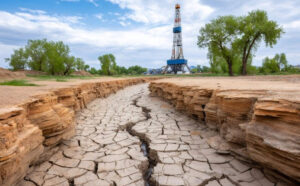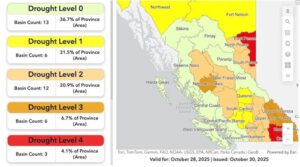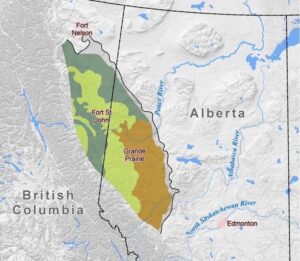
Rick Mills – “As drought grips northeastern BC, oil & gas companies pay a pittance for frack water”
One of a government’s most important roles is to ensure a safe water supply for its citizens, and to defend its citizens against threats to clean water resulting from industrial users who draw the water from the same sources as residents and then contaminate it.
Recent reports show the BC government is failing in this role and endangering the lives of people living in northeastern British Columbia and their environment.
Drought in northeastern BC
Much of northeastern BC is in severe or extreme drought, which has dried up rivers, stressed reservoirs and forced local governments to restrict water use, states CBC News, adding that the Peace Region’s snowpack was only 76% of normal last spring, and 65% in 2024. Earlier melts and hotter, drier summers are leaving little moisture to recharge rivers or groundwater.
Source: B.C. Drought Information Portal
Water levels along the Kiskatinaw River, the only source of water for the nearby town of Dawson Creek, are at historical lows, prompting local officials to declare a state of emergency. They want the province to fast-track a $100-million pipeline to pipe water from the Peace River more than 50 kilometers away. The officials are seeking access to 10 million cubic meters of water per year, The Tyee reported in October.
Exploiting the resource
In June of this year, Phase 1 of LNG Canada began shipping cargoes of liquefied natural gas from Kitimat to buyers in Asia. A Phase 2 expansion has begun that will add two more liquefaction trains, increasing the plant’s total capacity to 28 million tonnes per year.
Despite opposition to it, the Coastal GasLink pipeline is operational, sending natural gas 670 km from Dawson Creek to the LNG Canada facility in Kitimat.
How do we get the natural gas for LNG? We frack it. Most of the conventional natural gas formations in British Columbia have already been depleted. What’s left is “tight gas” trapped in shale rock formations, primarily the Montney in northeastern BC. According to the B.C. Energy Regulator, formerly the B.C. Oil and Gas Commission, 88% of BC’s remaining natural gas reserves are unconventional, which involves fracking.
The Montney formation, which straddles BC and Alberta.
Map from Wikimedia Creative Commons.
Advocacy groups say provincial policy continues to undervalue its water resources as the province pushes to expand major projects, from mining to LNG to AI data centers.
BC’s industrial water users pay just $2.25 per million liters, the lowest in Canada and far below the $54 to $79 charged in other provinces.
In the CBC News story, Minister of Energy and Climate Solutions Adrian Dix defended the province’s policies, stating that “Every licence is reviewed and controlled. Streamflow levels are very important. That’s what the B.C. Energy Regulator does in every case. In other words, puts the environment and human health first.”
Dix, the former health minister, added that BC’s water management framework remains “the most rigorous” in North America, developed from scientific advice provided by an expert panel in 2018.
Despite this, northeastern BC residents and organizations like Stand.earth and the BC Watershed Security Coalition are calling on the provincial government to dramatically increase water rental rates to be on par with other provinces.
According to The Tyee:
Stand.earth would [also] like the government to “require the treatment and increased reuse of fracking wastewater,” which would help to lower the vast amounts of fresh water now being used in the fracking process.
Currently, the industry’s treatment of its toxic wastewater, which is laden with heavy metals, is highly saline and may contain normally occurring radioactive compounds as well, is essentially no treatment at all but holding it for reuse or pumping it underground for permanent disposal.
At AOTH, we know that fracking comes at huge costs — environmental and human.
BC’s LNG boondoggle continues to lack critics — Richard Mills
Because of the drought local residents say black sand is showing up in their wells, crop yields are thinning, trees are dying prematurely and weeds like Canada thistle have exploded. Winter winds at times blow more dust instead of snow, the CBC describes.
And industry demand for water in the region is definitely on the rise.
According to public filings from the B.C. Energy Regulator, withdrawals by oil and gas companies have nearly tripled in recent years, from 3.6 million cubic meters in 2017 to just over 9 million in 2024. From the CBC:
Roughly half that water went to fracking, with the rest used for pipeline commissioning, dust control, equipment washing and other work “where much of the water is returned to the water cycle,” the regulator said… about 68 per cent of water used for fracking in B.C. is now reused wastewater.
This is extremely misleading. The water used for fracking is not recycled; in most cases it is pumped, untreated, underground, forever. The FracFocus database referenced by The Tyee shows that the total water pumped underground at fracked wells in BC in 2024 was 11.7 million cubic meters, about 30% more than what the BCER reported in its annual water use summary for last year. (The BCER report only covers water withdrawn under short-term permits and longer-term water licenses issued by the BCER to fracking companies). The Tyee states:
The additional 30 per cent may include water purchased from landowners and private companies as well as “flowback” or “recycled” wastewater that is highly toxic and is captured by oil and gas companies at well bore heads following fracking.
As reported previously by The Tyee, energy analyst David Hughes has warned that advancements in fracking technology mean that companies are drilling much longer wells.
The length of horizontal well bores in the Montney formation, which underlies Dawson Creek, Fort St. John and other Peace River communities, is now 2.7 kilometers on average.
“Water injection intensity has increased 45 per cent to an average of 8,346 litres per metre and an average well now consumes 23.1 million litres, a 10-fold increase since 2010,” Hughes concludes.
Allan Chapman, a former hydrologist with the oil and gas commission, in 2021 presented data documenting the steady rise in frack water use per well year over year, from less than 3,000 cubic meters per well in 2008 to almost 20,000 in 2021.
From 2021 to 2024, the average water use per well increased by 20% to almost 24,000 cubic meters.
Source: Allan Chapman
A report released last month concludes that water use by the region’s fracking industry shot up a record 50% last year.
According to the Tyee, Hughes suggests a possible doubling of well drilling and fracking in the coming few years to feed LNG Canada, with an annual water demand double or triple its current level.
Poisoning the well
In hydraulic fracturing, a concoction of chemicals, water and frac sand is pumped into a well at high pressure to break apart the shale rock to create fissures that release the natural gas.
Fracking defenders say the process is perfectly safe and contained. Not true. The reality is that really nasty carcinogenic pollutants are released throughout the process — into the air and water.
Natural gas is mostly methane (CH4), a potent greenhouse gas that is over 25 times more efficient than carbon dioxide at trapping heat in the atmosphere over a 100-year period. The Global Methane Pledge from COP26 acknowledges that methane is one of the most potent greenhouse gases, responsible for a third of current warming from human activities.
Most methane leaks come from flaring excess NG instead of putting it into a pipeline.
Fracking just one well can use 2 to 8 million gallons of water with the major components being water (90%), sand or proppants (8-9.5%), and chemicals (0.5-2%), doesn’t sound like much right? Read on. One 4-million-gallon fracturing operation uses from 80 to 330 tons of chemicals, and each well is fracked numerous times. Many of these chemicals have been linked to cancer, developmental defects, hormone disruption, and other conditions. The water gets contaminated after the fracking process and is disposed of in tailings ponds or is injected into deep underground reservoirs.
Cracked wells and rock movement frequently leak fracking fluid and gases into nearby groundwater supplies. Fracturing fluid leak-off (loss of fracturing fluid from the fracture channel into the surrounding permeable rock) can exceed 70% of injected volume.
Methane concentrations are 17 times higher in drinking-water wells near fracturing sites than in normal wells. Hydraulic fracturing increases the permeability of shale beds, creating new flow paths and enhancing natural flow paths for gas leakage into aquifers.
Fracking has also caused benzene poisoning among pregnant women in northeastern BC – natural gas country — and is known to cause earthquakes (read more below).
In other cases, it has depleted precious, limited fresh water supplies depriving other users of necessary irrigation or drinking water.
In April 2022, CBC reported on a University of Calgary study that said there may be a link between the density of oil and gas operations and increased health risk for pregnant women and their babies.
The rate of pre-term deliveries — birth before 37 weeks — was found to increase significantly relative to the number of fracturing sites within 10 kilometers of their home.
According to the study, women living near between one and 24 well sites had a 7.4% risk of early delivery, and the risk increased to 11.4% for those near 100 or more fracking operations. Premature births present a number of health risks including neurodevelopmental difficulties, physical disabilities and behaviour problems, including autism, cerebral palsy and epilepsy.
Another study found homes close to fracking sites had higher levels of organic pollutants that may lead to short and long-term health effects.
Researchers took water and air samples from the homes of 85 pregnant women in the Peace River area for one week. They found the amount and proximity of natural gas wells to the home were linked to higher levels of certain chemical contaminants… results showed that air samples in homes near the natural gas well sites had higher levels of chemicals used in fracking, such as acetone and chloroform, and those same contaminants were found in their study subjects.
Earthquake risk
With fracking, some of the wastewater is pumped underground into waste wells or saline aquifers. There are serious concerns about the ability of these waste wells and aquifers to handle the increased pressure. The evidence is showing that deep-well injecting, and fracking, are linked to earthquakes.
The connection between fracking/ wastewater injection and earthquakes has been strenuously denied by the industry. But a study published in 2016 found that both fracking wells and wastewater disposal wells, drilled near the border between BC and Alberta, could be linked to earthquakes of magnitude 3 or larger. More recently:
According to monitoring data from Natural Resources Canada, there were 34 recorded earthquakes at magnitude 3 and above (M>3.0) in Montney, more than three times the amount 10 years ago.(CBC News).
Moreover, the need for so much fresh water in the fracking process has resulted in the construction of dozens of unlicensed dams in northeastern BC, many of which are unsafe.
At least 92 unauthorized dams have been built in northeastern BC, to be used exclusively by oil and gas companies for the purpose of fracking. Nearly a third were found to have structural problems including a lack of spillways. No companies have been fined for violating the rules.
LNG not green
Along with LNG Canada Phases 1 and 2, several liquefied natural gas facilities are under construction or in the final stages of development in British Columbia, primarily in Kitimat and Squamish. The other major projects include the Woodfibre LNG project near Squamish, which is slated to begin operations in 2027. The Cedar LNG project in Kitimat, a floating facility with significant indigenous ownership, is in the early stages of construction, targeting late 2028 for operations, and the Ksi Lisims LNG project near the northern tip of Pearse Island is in the environmental and community engagement phase. (AI Overview)
Despite claims by the operators of current and future BC LNG facilities that they are “clean and green”, the reality is they are anything but.
We already know that LNG Canada in just the first phase of production will result in 36.4 million tonnes of emissions, which is more than half of British Columbia’s current annual emissions.
Cedar LNG would produce quite a bit less, just 7.8Mt, but as The Sierra Club calculates, that is still more than the 6.5Mt generated annually by the city of Vancouver.
Most importantly, the new rules continue to ignore the additional emissions related to fracking, pipelines, shipping and re-gasification, including the leakage of methane, a greenhouse gas that is 86 times more powerful than CO2 over a 20-year period.
We all need to remember, extracting natural gas through hydraulic fracturing, transporting it to a terminal, and then super-cooling it for shipping in tankers, is not clean energy; in fact, it’s as dirty, or dirtier than coal. According to two reliable sources, methane from the production of natural gas makes LNG about as bad a greenhouse gas emitter as coal, and that when it comes to lifecycle GHG emissions, LNG sometimes emits more than coal.
Contrary to the industry’s message, there is also no evidence that LNG exports would reduce coal use around the world. A 2023 report found that China is building six times more coal plants than other countries. This massive increase in the use of coal is happening despite China’s state-owned enterprise PetroChina holding a 15% ownership stake in the LNG Canada joint venture.
As part of this agreement, PetroChina is entitled to and has committed to off-take 1.8 million tonnes per annum (MTPA) of LNG for a minimum of 20 years. This represents its pro-rata share of the facility’s Phase 1 production capacity of 14 MTPA (approx. 1.84 billion cubic feet per day).
To your author it’s beginning to feel as if no one can trust anything the LNG backers, company officials or our politicians say about what is happening within the industry or to BC and it’s residents
In July 2025, PetroChina lifted the fifth ever cargo from the new LNG Canada facility, marking the beginning of these larger-scale shipments.
To turn it into liquid form, the gas must be cooled to 163 degrees below zero. To do that requires a great deal of power, with massive compression units running 24/7. Where does that power come from? In most cases, the same fracked natural gas is used to run the compression units, which defeats the purpose of LNG as “clean”.
The BC government likes to say that LNG Canada is powered by hydroelectricity. The reality is this: LNG Canada’s Phase 1 is primarily powered by natural gas-fired turbines for the liquefaction process, with only about 20% of its total power needs met by electricity from B.C. Hydro. The Crown corporation does plan to transition to electric motors for Phase 2, “as transmission infrastructure allows.” (much of it will come from Site C, recently completed at a massively overbudget $16 billion — Rick)
On October 21st of this year the BC government clearly admitted, in Bill 31, that the province does not have the electricity supply it needs to satisfy both the province’s climate and development goals.
“This legislation confirms that BC does not have an ‘abundance’ of clean electricity as claimed in the CleanBC policy. Why else would Bill 31 give Cabinet sweeping new powers to centralize decision-making over which industries can receive electricity from BC Hydro, and which ones will be left out in the cold?” Barry Penner, KC, Chair of the Energy Futures Institute.
Way back in 2014, B.C. Hydro and LNG Canada signed a power deal governing how much LNG Canada would pay for electricity it gets from the B.C. Hydro grid. The story confirms that LNG Canada will use natural gas turbines to drive the compressors to chill natural gas to liquid form.
According to Wood Mackenzie, LNG will be the biggest source of carbon emission growth by 2025 – due to strong demand from Asian buyers.
Emissions from the first and second phase would represent nearly three-quarters of the province’s legislated target for greenhouse gas emissions in 2050, set at 13 megatonnes/yr.
Opponents say the project will blow the NDP’s goal of cutting GHGs by 40% by 2030 and 80% by 2050, out of the water.
Conclusion
The current drought in northeastern BC is pitting local residents and municipalities against industrial users, i.e., the fracking industry, for scarce water supplies.
At AOTH, we’ve been warning about the dangers of LNG and the high cost of this so-called “bridge” fuel in terms of human health and the environment ever since it was but a gleam in a previous premier’s eye.
Out of 9 million cubic meters of water drawn by oil and gas companies, roughly half went to fracking; water use by the region’s fracking industry shot up a record 50% last year.
One 4-million-gallon fracturing operation uses from 80 to 330 tons of chemicals, and each well is fracked numerous times. Many of these chemicals have been linked to cancer, developmental defects, hormone disruption, and other conditions. The water gets contaminated after the fracking process and is disposed of in tailings ponds (where contaminants evaporate off into the air and surrounding environment) or is injected into deep underground reservoirs and subject to leaks into surrounding watersheds.
The BC government is enabling this travesty by practically giving away the water the industry uses for fracking, which pollutes the air and water and causes earthquakes; a ridiculously low $2.25 per million liters, the lowest in Canada. Ironically, it’s about the same as a larger bottle of water. For sucking out a million liters from streams, rivers and lakes the local population depends on for drinking water and irrigation.
The number of LNG projects green-lighted by the BC government continues to increase, all of them fed by fracked gas. My crystal ball shows that, so long as northeastern BC remains dry, the fight over fresh water is going to get very nasty indeed.
Richard (Rick) Mills
aheadoftheherd.com
Subscribe to AOTH’s free newsletter
Legal Notice / Disclaimer
Ahead of the Herd newsletter, aheadoftheherd.com, hereafter known as AOTH.
Please read the entire Disclaimer carefully before you use this website or read the newsletter. If you do not agree to all the AOTH/Richard Mills Disclaimer, do not access/read this website/newsletter/article, or any of its pages. By reading/using this AOTH/Richard Mills website/newsletter/article, and whether you actually read this Disclaimer, you are deemed to have accepted it.
Any AOTH/Richard Mills document is not, and should not be, construed as an offer to sell or the solicitation of an offer to purchase or subscribe for any investment.
AOTH/Richard Mills has based this document on information obtained from sources he believes to be reliable, but which has not been independently verified.
AOTH/Richard Mills makes no guarantee, representation or warranty and accepts no responsibility or liability as to its accuracy or completeness.
Expressions of opinion are those of AOTH/Richard Mills only and are subject to change without notice.
AOTH/Richard Mills assumes no warranty, liability or guarantee for the current relevance, correctness or completeness of any information provided within this Report and will not be held liable for the consequence of reliance upon any opinion or statement contained herein or any omission.
MORE or "SLIDER"
Jeff Christian - "Why Gold And Silver Prices Could Drop Further And Surge Higher" (Video)
In this presentation Jeffrey Christian of CPM Group discusses the current pause in gold, silv... READ MORE
Arizona Gold & Silver Drills +34 Metres of Perry Vein in New Drill Hole 60 Metres North of Previous High-Grade Intersection on The Philadelphia Project, Arizona
Arizona Gold & Silver Inc. (TSX-V: AZS) (OTCQB: AZASF) is pleased to announce it has successfu... READ MORE
Prismo Metals Provided Extensions on Hot Breccia Copper Project
Prismo Metals Inc. (CSE: PRIZ) (OTCQB: PMOMF) is pleased to announce that Walnut Mines LLC, the owne... READ MORE
BacTech Strengthens Balance Sheet Through Convertible Debenture Restructuring, Reducing Outstanding Debt
BacTech Environmental Corporation (CSE: BAC, OTCQB: BCCEF, FSE: 0BT1) today announced that it has ta... READ MORE
















